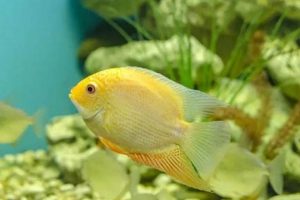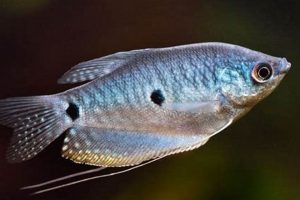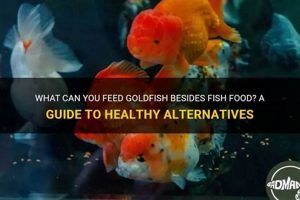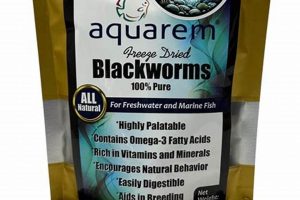The sustenance required by Synchiropus splendidus and related species presents a unique challenge to aquarists. These fish are notoriously picky eaters, demanding a diet primarily consisting of live copepods and amphipods. These tiny crustaceans provide the essential nutrients that the fish requires. Providing adequate quantities of these live foods is crucial for the fish’s survival.
The availability of appropriate nourishment is fundamental to the health and longevity of these visually striking creatures in captivity. Historically, many attempts to keep them failed due to an inability to replicate the complexity and abundance of their natural diet found on coral reefs. Successful husbandry now depends on either well-established reef aquariums with flourishing microfauna populations, or on the regular addition of cultured live foods.
The following sections will elaborate on suitable live food sources, methods for culturing these invertebrates, and strategies to ensure adequate feeding in a captive environment. Detailed nutritional requirements and considerations for supplementary feeding will also be discussed.
Guidance on Dietary Requirements
Optimal care of Synchiropus splendidus involves meticulous attention to its dietary needs. Due to its selective feeding habits, success in maintaining this fish hinges on adhering to specific protocols.
Tip 1: Establish a Robust Copepod Population: A thriving population of copepods within the aquarium is paramount. This serves as a constant, natural food source, mimicking the fish’s grazing behavior in the wild. Introduce copepods regularly, allowing them to establish themselves before introducing the fish.
Tip 2: Supplement with Amphipods and Other Live Foods: While copepods are essential, supplementing the diet with amphipods and other small live invertebrates offers a broader range of nutrients. Varying the food source can help prevent nutritional deficiencies.
Tip 3: Observe Feeding Behavior: Closely monitor the fish’s feeding habits. Observe whether it is actively hunting copepods or amphipods. Lack of feeding activity can indicate stress, illness, or insufficient food availability.
Tip 4: Quarantine New Specimens: Before introducing a new specimen into the main aquarium, quarantine it in a separate tank with an established copepod population. This allows the fish to acclimate to captivity and demonstrates its ability to feed.
Tip 5: Consider a Refugium: A refugium connected to the main aquarium can serve as a breeding ground for copepods and other small invertebrates. This provides a continuous supply of live food, enhancing the stability of the ecosystem.
Tip 6: Avoid Competition: Minimize competition from aggressive tank mates that may consume copepods or harass the fish. Peaceful, reef-safe species are the most suitable tank companions.
Tip 7: Provide Ample Hiding Places: Offer plenty of hiding places within the aquarium. This reduces stress and allows the fish to feel secure, encouraging natural feeding behaviors.
Adherence to these guidelines significantly improves the likelihood of successfully keeping Synchiropus splendidus, ensuring its health and well-being within a captive environment. Consistent attention to the availability of appropriate live food is the cornerstone of their long-term care.
The following sections will discuss the challenges of cultivating live food sources and strategies for addressing common feeding-related issues.
1. Live copepod cultures
Live copepod cultures represent a fundamental component in the successful maintenance of Synchiropus splendidus, as they serve as a primary and often indispensable food source for these fish in captivity. The delicate feeding habits of these fish necessitate a continuous supply of these microscopic crustaceans.
- Species Selection and Suitability
Different species of copepods vary in size, nutritional value, and ease of culture. Selecting appropriate copepod species that align with the mouth size and nutritional requirements of Synchiropus splendidus is essential. For instance, Tigriopus californicus and Apocyclops panamensis are commonly used due to their manageable size and relatively simple culture requirements.
- Culture Establishment and Maintenance
Establishing and maintaining a thriving copepod culture requires controlled environmental conditions. Salinity, temperature, and water quality must be carefully monitored and maintained. Regular feeding with phytoplankton cultures or commercially available copepod feeds is also necessary to sustain the population. Overcrowding and poor water quality can lead to culture crashes, highlighting the importance of consistent monitoring and management.
- Nutritional Enrichment Strategies
The nutritional value of copepods can be enhanced through enrichment techniques. Feeding copepod cultures with phytoplankton enriched with essential fatty acids, vitamins, and other micronutrients can improve their nutritional profile. This subsequently benefits the Synchiropus splendidus that consume them, ensuring they receive a more complete and balanced diet. Commercial enrichment products are also available and can simplify this process.
- Delivery Methods to the Aquarium
Efficient delivery methods are crucial for ensuring that copepods reach the fish. Simply adding copepods to the main aquarium can result in many being consumed by other inhabitants or lost in the substrate. Refugiums, which are separate, protected areas of the aquarium, can serve as breeding grounds for copepods, allowing them to migrate naturally into the main tank. Alternatively, targeted feeding methods using specialized containers or slow-release mechanisms can deliver copepods directly to the fish’s feeding zone.
The interplay between these elements dictates the efficiency with which live copepod cultures can support the nutritional needs of Synchiropus splendidus. Consistent application of these strategies significantly increases the likelihood of maintaining healthy and thriving specimens in captive environments. Continuous refinements in culture techniques and a thorough understanding of nutritional requirements remain crucial for the long-term success of keeping these unique fish.
2. Nutritional Enrichment Methods
The practice of nutritional enrichment represents a critical strategy in the successful maintenance of Synchiropus splendidus, directly impacting the nutritional value of their primary food source and, consequently, their overall health and survival in captive environments.
- Phytoplankton Enrichment of Copepods
Copepods serve as a primary food source, and their nutritional content can be significantly enhanced by feeding them phytoplankton rich in essential fatty acids, vitamins, and amino acids. For instance, supplementing copepod cultures with Nannochloropsis or Tetraselmis boosts their omega-3 fatty acid content, crucial for the visual acuity and neurological function of Synchiropus splendidus. This process directly improves the nutritional value of the diet provided to the fish.
- Liposome Encapsulation of Vitamins and Supplements
Liposome encapsulation involves encasing vitamins and other micronutrients within lipid spheres, facilitating their absorption by copepods. This method protects these nutrients from degradation and enhances their bioavailability once consumed by the fish. For example, encapsulating Vitamin B12 and Vitamin C in liposomes and then feeding the liposomes to copepods can ensure that these essential vitamins are effectively transferred to the fish, addressing common deficiency issues.
- Commercial Enrichment Products
Commercially available enrichment products offer a standardized and convenient method for enhancing the nutritional profile of copepods. These products typically contain a balanced blend of vitamins, minerals, and essential fatty acids specifically formulated to meet the nutritional needs of marine organisms. Incorporating these products into copepod cultures, following manufacturer’s instructions, simplifies the enrichment process and ensures consistency in dietary quality.
- Direct Supplementation of Live Foods
Directly supplementing live foods, such as newly hatched brine shrimp or rotifers, with vitamin and mineral solutions can also contribute to the nutritional enrichment process. Soaking these organisms in enrichment solutions before feeding them to copepods can further enhance the nutritional content of the copepods, providing an additional layer of dietary supplementation for Synchiropus splendidus. However, careful attention must be paid to the dosage and exposure time to avoid harming the live food.
These enrichment methods, when implemented effectively, significantly improve the nutritional quality of the diet provided to Synchiropus splendidus, addressing potential nutritional deficiencies and promoting vibrant coloration, robust immune function, and overall health. By ensuring that the copepods and other live foods consumed by these fish are nutritionally complete, aquarists can more closely replicate the balanced diet they would receive in their natural coral reef habitat, leading to improved success in their long-term care.
3. Feeding frequency optimization
The feeding frequency optimization in relation to Synchiropus splendidus‘ dietary needs constitutes a critical parameter in successful husbandry. These fish are continuous grazers in their natural reef habitat, feeding on small invertebrates throughout the day. Translating this behavior to the aquarium environment necessitates careful consideration of feeding frequency to ensure adequate nutrient intake and prevent malnutrition. Infrequent feeding can result in emaciation, increased susceptibility to disease, and ultimately, mortality. Optimization, therefore, focuses on replicating the natural grazing behavior as closely as possible within the confines of the captive environment. For example, establishing a refugium population provides a continuous supply of live food, minimizing the need for frequent direct feeding.
The practical application of optimized feeding frequencies involves several strategies. Firstly, the use of multiple daily feedings, rather than a single large feeding, is recommended. This allows the fish to access food consistently throughout the day. Secondly, the volume of food offered at each feeding should be carefully calibrated to prevent overfeeding, which can lead to water quality issues. The key lies in balancing the supply of food with the fish’s demand, constantly monitoring the fish’s body condition and adjusting the feeding schedule accordingly. Aquariums with established microfauna populations can rely more on the natural food supply, while newly established tanks require more frequent supplementation with cultured live foods. Automatic feeders can also be used to dispense small amounts of food at regular intervals throughout the day, mimicking the natural grazing pattern of the fish.
In conclusion, feeding frequency optimization is intrinsically linked to the successful provision of appropriate food for Synchiropus splendidus. Neglecting this aspect can lead to significant health problems and reduced lifespan. The challenges lie in accurately assessing the fish’s individual needs and implementing a feeding strategy that replicates their natural grazing behavior. Continuous monitoring of the fish’s condition and water quality is essential for adjusting the feeding regime as needed, ensuring that the fish receives adequate nutrition while maintaining a stable and healthy aquarium environment.
4. Refugium establishment
The establishment of a refugium is a strategic component in the successful maintenance of Synchiropus splendidus. This supplementary ecosystem provides a protected environment for the cultivation of live food, directly addressing the nutritional challenges associated with these fish.
- Copepod Production and Sustained Food Supply
Refugia serve as breeding grounds for copepods, amphipods, and other small invertebrates. These organisms comprise the primary diet of Synchiropus splendidus. A well-established refugium provides a continuous and self-sustaining supply of these essential live foods. For instance, a refugium populated with macroalgae like Chaetomorpha offers a habitat where copepods can thrive, free from predation, and reproduce rapidly. This steady supply reduces the reliance on external copepod cultures and ensures a more consistent food source for the fish.
- Nutrient Export and Water Quality Enhancement
Refugia also contribute to the overall water quality of the aquarium system. Macroalgae within the refugium absorb excess nutrients, such as nitrates and phosphates, reducing the risk of algal blooms in the main display tank. This improved water quality is indirectly beneficial, as it supports a healthier environment for both the Synchiropus splendidus and the copepod populations. Reduced nutrient levels also encourage the growth of beneficial bacteria, which further contribute to the stability of the ecosystem.
- Habitat for Beneficial Invertebrates
In addition to copepods, refugia provide a sanctuary for other beneficial invertebrates, such as amphipods and small worms. These organisms contribute to the biodiversity of the aquarium and can supplement the diet of the fish. The presence of these diverse organisms also promotes a more natural and balanced ecosystem. For example, amphipods can consume detritus, further aiding in nutrient cycling and maintaining water quality.
- Reduced Competition and Predation
By providing a separate and protected environment, refugia minimize competition and predation on copepods. This allows the copepod population to flourish, ensuring a more abundant food supply for the Synchiropus splendidus. In the main display tank, copepods are often consumed by other fish and invertebrates, limiting their availability. The refugium acts as a safe haven, where copepods can reproduce and grow without the constant threat of predation.
The integration of a refugium into the aquarium system represents a proactive approach to addressing the dietary needs of Synchiropus splendidus. It offers a sustainable and natural solution for providing a consistent supply of live food, enhancing water quality, and promoting a more balanced ecosystem. The long-term success of keeping these fish relies heavily on the establishment and proper maintenance of a functional refugium.
5. Behavioral feeding cues
Behavioral feeding cues are critical indicators of the adequacy of offered nourishment for Synchiropus splendidus. The presence or absence of specific behaviors directly reflects the fish’s acceptance of, and ability to thrive on, the provided diet. For instance, active hunting throughout the day within the established microfauna indicates a healthy interest in available food and a positive energy balance. Conversely, a lack of interest in hunting, characterized by lethargy and a refusal to forage amongst the copepod population, often signals insufficient food availability, inappropriate food size, or the presence of stressors affecting appetite. Such behavioral changes serve as early warnings of potential malnutrition.
Specific examples highlight the practical significance of observing feeding cues. A sudden decrease in hunting activity, coupled with a visible thinning of the fish’s body, necessitates an immediate assessment of copepod population density and the introduction of supplementary feeding with enriched live foods. Similarly, observing the fish repeatedly attempting to consume food items that are too large indicates a need to adjust the size of the copepod cultures being introduced. Furthermore, the observation of rapid gill movement and labored breathing during feeding may suggest that the copepods are contaminated or of poor quality, necessitating a change in copepod culture methods. These behavioral observations enable aquarists to make timely adjustments to dietary management.
In summary, behavioral feeding cues function as a real-time monitoring system for assessing the effectiveness of feeding strategies. Diligent observation and interpretation of these cues provide valuable insights into the well-being and nutritional status of Synchiropus splendidus, facilitating informed decisions regarding food type, feeding frequency, and overall aquarium management. Ignoring these cues can lead to severe health problems and reduced lifespan, emphasizing their importance in successful husbandry. Understanding and responding to these signals is, therefore, an essential component of responsible care.
Frequently Asked Questions Regarding Mandarin Fish Sustenance
The following addresses prevalent inquiries and misunderstandings concerning the dietary requirements and proper feeding protocols for Synchiropus splendidus.
Question 1: What constitutes the primary dietary component for maintaining the health of a mandarin fish?
A mandarin fish’s primary dietary requirement consists of live copepods. These minute crustaceans provide essential nutrients and mimic the natural grazing behavior of the fish within its native reef environment. The consistent availability of live copepods is paramount for long-term survival.
Question 2: Can commercially available dry foods adequately sustain a mandarin fish?
While some individual specimens may eventually accept certain high-quality, small-particulate dry foods, these are not generally considered a suitable primary diet. Mandarin fish are notoriously picky eaters, and relying solely on dry food often leads to malnutrition and eventual decline. Dry foods should, at best, serve as a supplemental addition to a diet rich in live copepods.
Question 3: How can one establish and maintain a sufficient copepod population within an aquarium?
Establishing a thriving copepod population requires a dedicated refugium, separate from the main display tank, or a well-established reef system with ample hiding places and minimal predation. Regular introduction of copepod cultures and the provision of suitable food sources, such as phytoplankton, are essential for sustaining the population.
Question 4: What are the signs of malnutrition in a mandarin fish?
Indications of malnutrition include a noticeably thin body, reduced activity levels, lack of interest in hunting, and a decline in vibrant coloration. If these signs are observed, immediate action to increase the availability of live copepods and assess water quality is necessary.
Question 5: How frequently should a mandarin fish be fed?
Mandarin fish are continuous grazers and should have access to live food throughout the day. Establishing a refugium to provide a constant supply of copepods is ideal. Supplemental feedings with enriched live copepods may be necessary, depending on the size of the aquarium and the density of the copepod population.
Question 6: Is it possible to keep a mandarin fish in a newly established aquarium?
Introducing a mandarin fish into a newly established aquarium is generally not recommended. New aquariums lack the established microfauna populations necessary to sustain these fish. It is advisable to wait until the aquarium has been running for several months and has a thriving copepod population before introducing a mandarin fish.
In summary, successful maintenance of Synchiropus splendidus hinges on a thorough understanding of its specific dietary needs and the consistent provision of live copepods. Vigilant observation and proactive management are essential for ensuring the health and longevity of these fish in captivity.
The following section will address specific feeding strategies and the cultivation of live food sources.
Conclusion
The intricacies of Synchiropus splendidus dietary management have been thoroughly explored, emphasizing the paramount importance of live copepods. The cultivation of these invertebrates, coupled with nutritional enrichment strategies and optimized feeding regimens, forms the cornerstone of successful husbandry. Behavioral observations serve as critical indicators of dietary adequacy, allowing for timely adjustments to feeding protocols. A functional refugium provides a self-sustaining ecosystem, addressing both the nutritional needs of the fish and contributing to overall water quality.
Effective management of the species dietary requirement ensures the continued health and well-being of these captivating creatures within artificial environments. The ongoing refinement of culture techniques and a commitment to proactive dietary management represent a necessary investment in the preservation of Synchiropus splendidus within the aquarium hobby.







